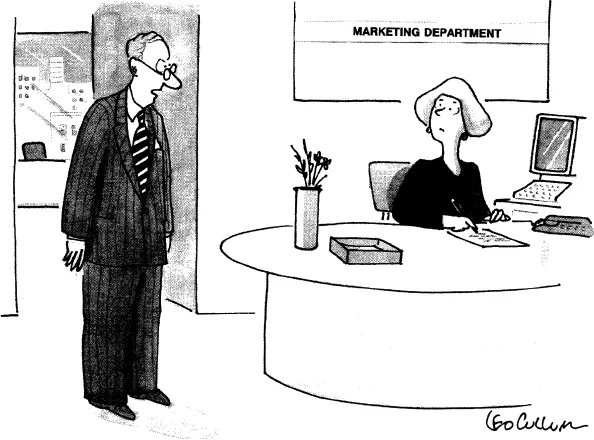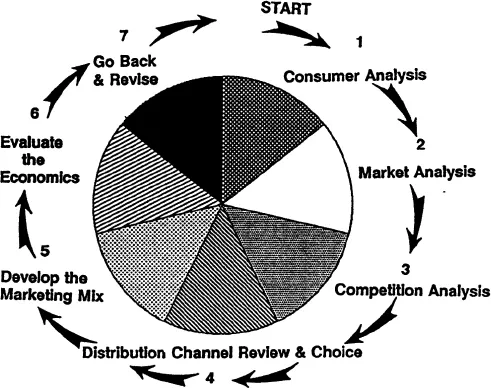![]()
Day 1
MARKETING
Marketing Topics
The 7 Steps of Marketing Strategy Development
The Buying Process
Segmentation
Product Life Cycle
Perceptual Mapping
Margins
The Marketing Mix and the 4 P’s
Positioning
Distribution Channels
Advertising
Promotions
Pricing
Marketing Economics
A scene from the boardroom of Acme Corporation:
DIRECTOR: Every time we do our annual review of our executives’ salaries, I cringe when I think that we are paying more to Jim Mooney, our vice president of marketing from Penn State, than to our company’s president, Hank Bufford from Harvard. I just don’t understand it.
CHAIRMAN OF THE BOARD: What don’t you understand? Without Jim’s sales we wouldn’t need a president—or anyone else for that matter!
“HOLD ALL CALLS. I’LL BE DOWN IN ACCOUNTING—FLEXING MY MUSCLES.”
Marketers see the world like the chairman of Acme. As renowned professor Philip Kotler of the Kellogg School at Northwestern teaches, marketing comes first. Marketing integrates all the functions of a business and speaks directly to the customer through advertising, salespeople, and other marketing activities.
Marketing is a special blend of art and science. There is a great deal to be learned in marketing classes, but no amount of schooling can teach you the experience, the intuition, and the creativity to be a truly gifted marketer. That’s why those with the gift are so highly paid. Formal education can only provide MBAs with a framework and a vocabulary to tackle marketing challenges. And that is the goal of this chapter and of the numerous expensive executive seminars conducted by the leading business schools.
The top schools prepare their students for executive marketing positions—in spite of the fact that their first jobs will likely be as lowly brand assistants at large food or soap companies. Therefore, the core curriculum stresses the development of full-fledged marketing strategies instead of the technical expertise needed on an entry-level job out of MBA school.
Numbers-oriented students tend to view marketing as one of the “soft” MBA disciplines. In fact, marketers use many quantitative or “scientific” techniques to develop and evaluate strategies. The “art” of marketing is trying to create and implement a winning marketing plan. There are literally an infinite number of possibilities that may work. McDonald’s, Burger King, Wendy’s, Hardee’s, and White Castle successfully sell burgers, but they all do it in different ways. Because there are no “right” answers, marketing classes can provide students with either an opportunity to show their individual flair, or many hours of frustration as they try to come up with creative ideas. Marketing was my favorite subject. It was fun cooking up ideas for discussion. My B-school buddies still kid me about the time I proposed to the class that Frank Perdue introduce a gourmet chicken hot dog.
THE MARKETING STRATEGY PROCESS
The marketing process is a circular function. Marketing plans undergo many changes until all the parts are internally consistent and mutually supportive of the objectives. All aspects of a proposal need to work together to make sense. It is easy to get one part right, but an internally consistent and mutually supportive marketing plan is a great accomplishment. It’s a seven-part process.
1. Consumer Analysis
2. Market Analysis
3. Review of the Competition and Self
4. Review of the Distribution Channels
5. Development of a “Preliminary” Marketing Mix
6. Evaluation of the Economics
7. Revision and Extension of Steps 1–6 until a consistent plan emerges
MARKETING STRATEGY DEVELOPMENT
Although there are seven steps, their order is not set in stone. Based on circumstances and your personal style, the order of the steps may be rearranged. This chapter could get bogged down in a morass of marketing theory, but to make it practical, I will outline the questions and areas that should be considered when developing a marketing plan. For expediency, I will concentrate on product marketing, but the same frameworks and vocabulary are also applicable to service marketing.
I will present the MBA models in the same seven-step order in which they are taught at the best schools. This chapter offers a generic structure to apply to whatever marketing issue you may encounter. I have not neglected to use the vocabulary taught at the schools, so you can pick up on the MBA jargon and speak like a real MBA marketer. Marketing is an area especially rich in specialized vocabulary. With the correct vocabulary, even your mediocre marketing ideas can appear brilliant. That may sound funny, but that’s the way ad agencies market their product, advertising.
This seven-step marketing process is comprehensive, and MBAs will often refer to more abbreviated ones, such as STP (segment, target, position), or the four C’s of marketing (consumer behavior, company analysis, competitor analysis, context), but the methodology presented here covers it all.
1. CONSUMER ANALYSIS
Consumer Analysis → Market → Competition → Distribution → Marketing Mix → Economics → Revise
All marketing plans should begin with a look at the all-important “consumer” and his or her needs. People do not have the same needs or desires. The objective of consumer analysis is to identify segments or groups within a population with similar needs so that marketing efforts can be directly targeted to them. Starting anywhere else tends to restrict your thinking and all subsequent analysis. Several important questions must be asked to find the market that will unlock untold marketing riches:
What is the need category?
Who is buying and who is using the product?
What is the buying process?
Is what I’m selling a high- or low-involvement product?
How can I segment the market?
What is the need category? Who needs us and why?
What is the need or use that your product addresses? The question may seem unnecessary, but in answering it you may uncover a potential market for the product that was previously overlooked. That is why this question has to be addressed first, before you begin to pollute your mind with conventional thoughts. The people at Arm & Hammer baking soda have done a great deal of this type of analysis. They have made use of their powder in their own brand of toothpaste, air freshener, and carpet freshener. In addition, they profitably recommend their raw baking-soda powder for hundreds of uses.
Who is buying versus who is using the product?
Buyers many times are different from users. Women, for example, make the majority of purchases of men’s underwear and socks. If an advertising campaign wanted to target the buyer of men’s socks, it would probably be inappropriate to buy space in Sports Illustrated. Determining the buyer as well as the user provides the essential initial insights to create a marketing plan.
What is the buying process?
Once you have established the need, and who is making the purchases, you should try to form a hypothesis on how the product is bought. Marketing research is a prime source of information, but just as valid are your own observations, investigation, and intuition.
Understanding the buying process is critical because it will lead to the possible routes to reach buyers. The buying process includes all the steps that a person takes leading to a purchase. It is also called the adoption process and the problem-solving process by some academics. Some researchers call it a Learn/Feel/Do process. Others call it AIDA, for Attention/Interest/Desire/Action. I have read extensively on this topic and have boiled the theories down to five steps. For any particular product, the buying process can include one or all of the following steps:
Awareness → Information Search → Evaluate Alternatives → Purchase → Evaluate
In the instance of a soap purchase, the process would look like this:
Smell Body → What Should I Use? → Soap → Ask Wife for Advice → Make Trip to the Store → Read Labels → Buy Dial Soap → Bathe → Smell Body fo...


